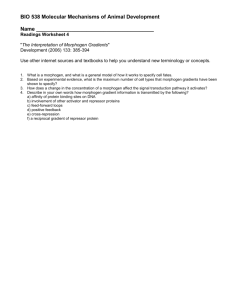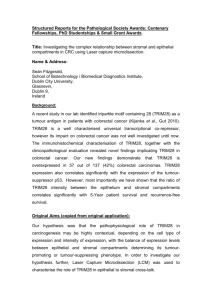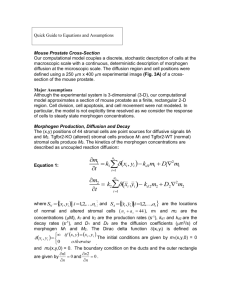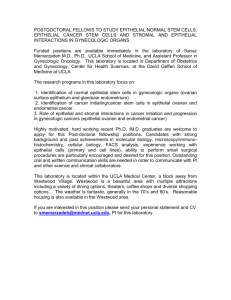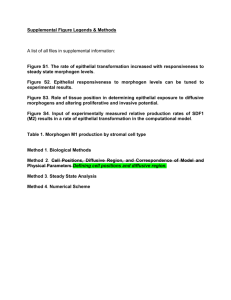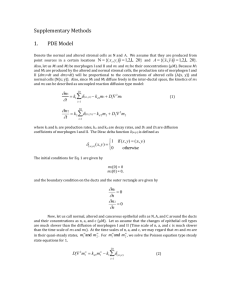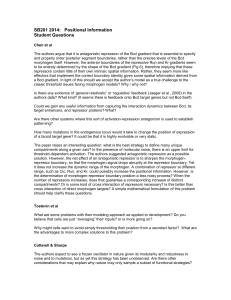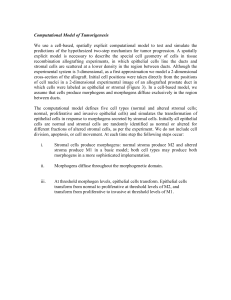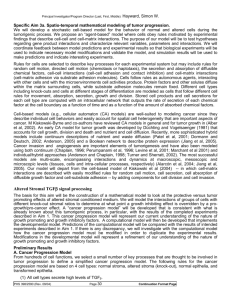Figures03_22_10 - University of South Alabama
advertisement
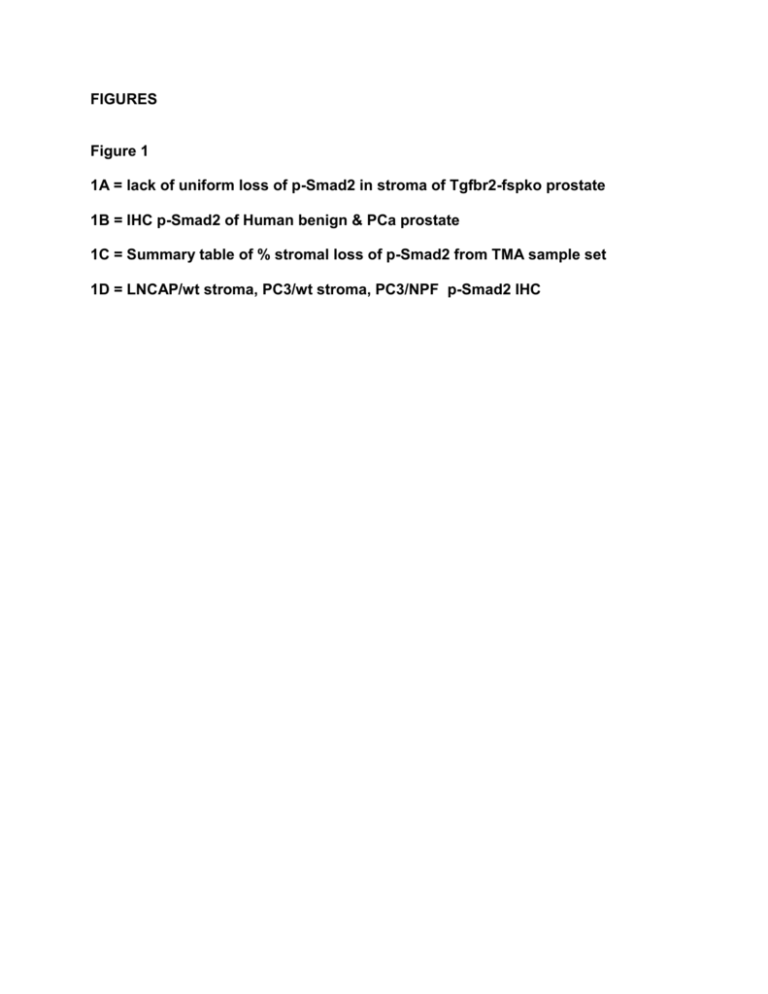
FIGURES Figure 1 1A = lack of uniform loss of p-Smad2 in stroma of Tgfbr2-fspko prostate 1B = IHC p-Smad2 of Human benign & PCa prostate 1C = Summary table of % stromal loss of p-Smad2 from TMA sample set 1D = LNCAP/wt stroma, PC3/wt stroma, PC3/NPF p-Smad2 IHC Figure 2 2A = NPF vs CAF total Smad 1/2/3 IF (cultured in serum) 2B = p-Smad2/Smad2/Actin WB NPF vs CAF 2C = SDF-1 ELISA NPF vs CAF 2D = Wnt3a Elisa NPF vs CAF Figure 3 = Tissue Recombs 100% WT WT 100% KO PIN 50/50 KO/WT PCa Figure 4 Figure 5 Figure 6 A B Figure 7 A B (i) (ii) (iii) Figure 8 A B Figure 89. Figure 10 Figure 911 Not done yet with the new model… should be the same though. Figure 1012 A Figure 1113 B C FIGURE LEGENDS Figure 1. Loss of TGF-beta signaling in human and mouse prostate tissues. A) Reduction in phospho-Smad2 staining in stroma associated with adenocarcinoma in Tgfbr2fspKO prostate. B) IHC demonstrating loss of nuclear p-Smad2 in human PCa but not benign prostate tissue samples ranked by Gleason score. C) Table summarizing pSmad2 results from human PCa tissue array. D) IHC p-Smad2 in tissue recombs LNCAP or PC3 w/ WT vs. KO stroma Figure 2. NPF vs CAF. A) total Smad 1/2/3 IF. B) p-Smad2/Smad2/Actin WB. C) SDF-1 ELISA. D) Wnt-3a ELISA. Figure 3. Percentage of WT and Tgfbr2fspKO stroma in prostate tissue recombinant sub-renal allografts promotes cancer progression. A) Normal glandular architecture observed by H&E of graft of WT prostatic epithelial organoids recombined with 100% normal Tgfbr2floxE2/floxE2 prostate stromal cells. B) Development of PIN lesions in grafts of WT prostatic epithelial organoids recombined with 100% Tgfbr2fspKO prostate stromal cells. C) Progression of adenocarcinoma in grafts of WT prostatic epithelial organoids recombined with a 50% / 50% mixture of Tgfbr2floxE2/floxE2 and Tgfbr2fspKO prostate stromal cells. Images are representative of sections from N=? tissue recombinant grafts per experimental group for number? of independent experiments. Figure 4. Two-step model of prostate tumorigenesis based on the Tgfbr2fspKO mouse. Hypothetical mechanism 2 for why SDF production is greatest in mixed stromal cells. For this case, TGFB knock-out stromal cells produce factor M1 for epithelial tansformation (Step 1) but also products are required from normal stromal cells for epithelial invasion (Step 2). Figure 5. Establishment of a biologically informed computational model. Experimental picture (Left) of H&E stained section of mouse prostate with normal glandular structure comprised of ductal units of basal and luminal epithelial cells surrounded by basement membrane and well-differentiated smooth muscle (stromal) cells. Corresponding positions of simulation cells (Right) assuming 50% altered stromal cells. Epithelial cells are shown in black, normal stromal cells are shown in blue, and altered stromal cells are shown in cyan. Figure 6. Results of simulations based upon the established mathematical model indicate that stromal heterogeneity alters the proliferative and invasive potential of the prostate epithelial cells. The computational model yields greatest invasion at heterogeneous mixtures of stromal cells and the extent of epithelial proliferation and invasion depends on the ratio of the production of morphogens to the threshold response to morphogens. A) The number of cells that have become proliferative (Step 1, dashed line) and number of cells that have also become invasive (Step 2, solid line) when the morphogen diffusion lengths of M1 and M2 are 200 and 300 m, respectively and the threshold T required for transformation in response to M1 and M2 are 0.0453 and 0.3432 morphogen units respectively. The total abundance of each morphogen produced per source (per cell) is fixed at A=10000 morphogen units. B) A phase diagram showing the final tissue classification as a function of M1 production by altered cells (y-axis) and M2 production by normal cells (x-axis) in a tissue that is a 50/50 mix of normal and altered stroma. If the production rate of both morphogens is low relative to the threshold needed for transformation, the cells remain normal. Morphogen diffusion lengths and thresholds for M1 and M2 are as in (A). Error bars indicate the standard error of 100 simulations. Figure 7. The rate of epithelial cell transformation increases with responsiveness to steady state morphogen levels. (A) Steady-state morphogen levels of M1 for a random pattern of 50% mixed altered and normal stromal. The color bar on the right indicates that brighter colored pixels correspond to higher morphogen concentrations. (B) The state of epithelia cells (normal = yellow, proliferative = red) when the threshold TM1 required for transformation is (i) 20 morphogen units, (ii) 5 morphogen units or (i) 1 moprhogen units. As the threshold decreases, epithelia cells transform in response to lower morpphogen levels and the number of transformed cells increases. Figure 8. The cell responsiveness to morphogen levels can be tuned to yield experimental results. In experiments, approximately 80% of epithelial cells became proliferative and 20% became invasive at a 50-50 mix of altered and normal stroma. A) The threshold of M1 TM1 that results in 80% transformation of epithelial cells (Step 1) at a 50-50 mix of altered and normal stroma is shown as a function of the morphogen diffusion length LM1. For a diffusion length of 200 m, the threshold yielding experimental proliferation rates is 0.045 morphogen units (star). B) The threshold of M2 TM2 that results in 20% transformation of epithelial cells (Step 2) at a 5050 mix of altered and normal stroma when parameters for morphogen M1 are LM1=200 m and TM1=0.045 morphogen units is shown as a function of the morphogen diffusion length LM2. For a diffusion length of 300 m, the threshold yielding experimental proliferation rates is 0.343 morphogen units (star). Error bars indicate the standard error of 100 simulations. Figure 89. Assessment of biological parameters for mRNA and protein expression of the candidate morphogens, Wnt-3a and SDF-1. Quantitative realtime PCR analysis of mRNA expression for Wnt-3a and SDF-1 from A) unsorted cultures of Tgfbr2floxE2/floxE2 and Tgfbr2fspKO prostate stromal cells grown separately or as mixed co-cultures at various ratios in 60mm dishes, B) FACS sorted cells from unlabeled Tgfbr2floxE2/floxE2 and CMFDA (green) dye labeled Tgfbr2fspKO prostate stromal cell co-cultures, and C) SDF-1 concentrations measured in conditioned medium from Tgfbr2floxE2/floxE2 and Tgfbr2fspKO prostate stromal cells grown in culture or co-culture for 72 hr after reaching confluenct by ELISA. Samples were normalized by measurement of total protein by BCA protein assay. Figure 10. The cell responsiveness to morphogen levels can not be tuned to yield experimental results when there is basal production of morphogens. The minimum threshold that will yield 0% proliferation in the case of 100% normal cells (dotted line) and the maximum threshold that will yield 80% proliferation in the case of 50% normal cells as a function of the diffusion length LM1. The abundance of morphogen M1 is AM1=10000 units. There is no intersection of the graphs, indicating no solution. Figure 911. Role of tissue position in determining epithelial exposure to diffusive morphogens and altering transformation and invasive potential. Averaging results over multiple simulations yields predictions about which epithelia cells are most vulnerable to transformation. Stromal cells are blue and epithelial cells are black, red or gray. A) Highest epithelial cell transformation rates in 50/50 mixed population. Red epithelial cells show cells that transform more than 9 out of 10 simulations. B) Epithelial cell transformation rates when there is exactly one altered stromal cell. Red epithelial cells show cells that transform more than 1 out of 10 simulations. Gray epithelial cells show cells that never transform. Simulation parameters are as in Fig 4A and statistics for coloring are averaged over 100 simulations. Figure 1012. Model results for different assumptions regarding the production of SDF. Fraction of epithelia that have become proliferative (dashed line) or invasive (solid line) verses the fraction of altered stroma if a) altered stromal cells produce SDF, b) altered cells produce SDF only if there are normal stromal cells, c) altered cells produce SDF in proportion to the fraction of normal cells. For all cases, morphogen parameters for diffusion length and threshold L and T are as in Fig 4A. For cases (a) and (b), the abundance of morphogen M2 yielded by each cell is A =10000 units, and for case (c) the abundance of morphogen M2 is a function of the fraction of altered stromal where A = 10000*(2-2*fN), where fN is the fraction of normal stroma. Figure 1113. Projected roles of TGF-B in tumorigenic model. TABLE LEGENDS
